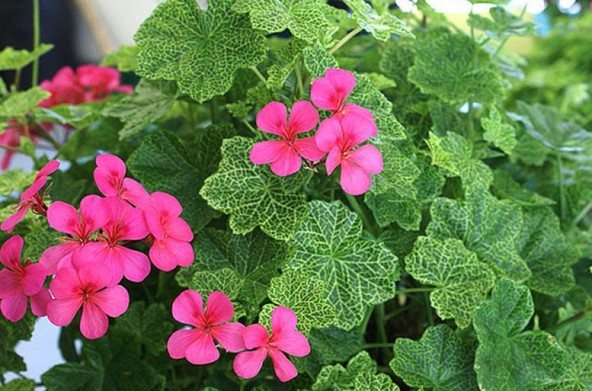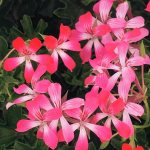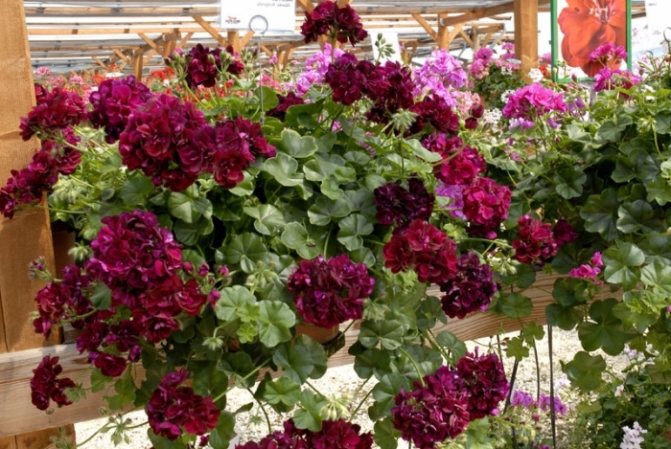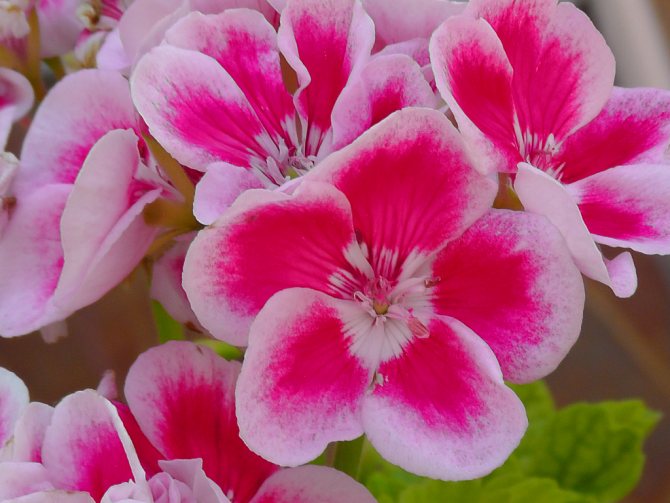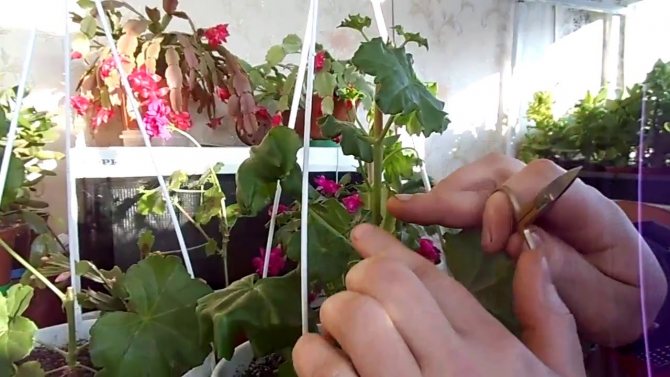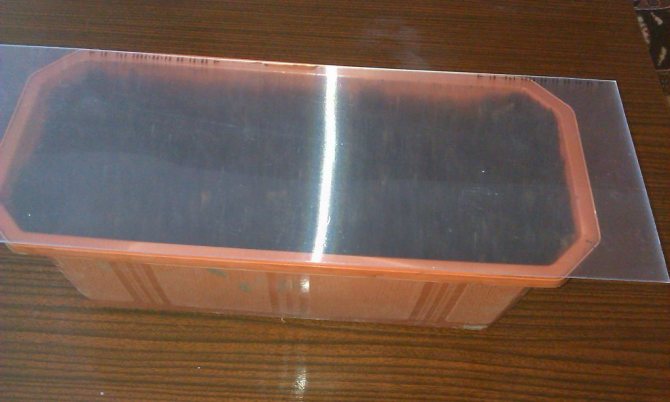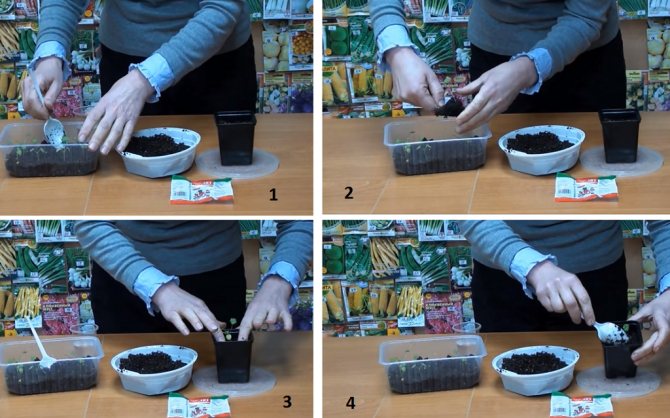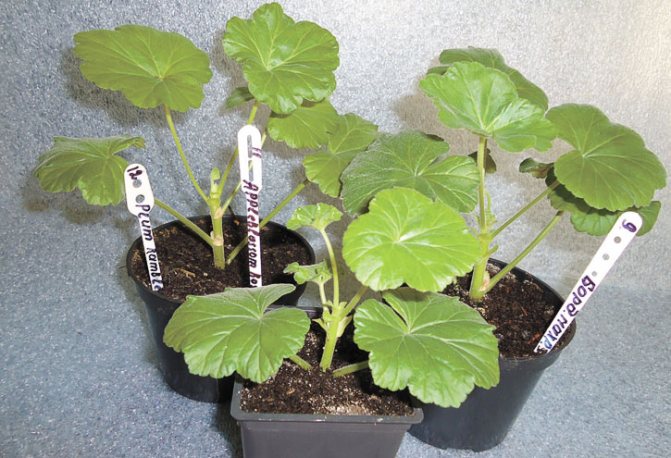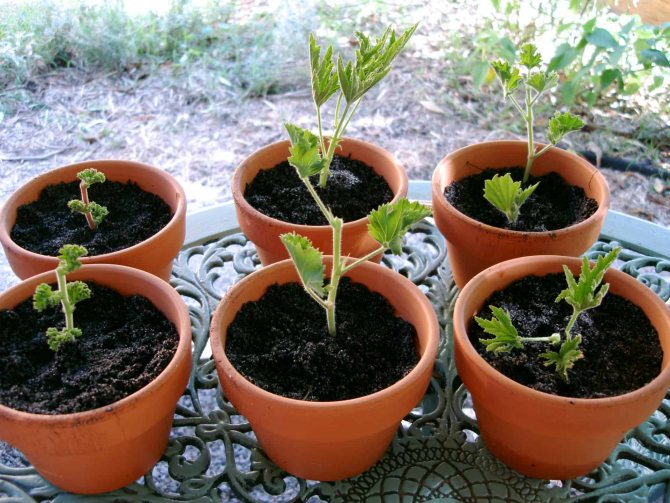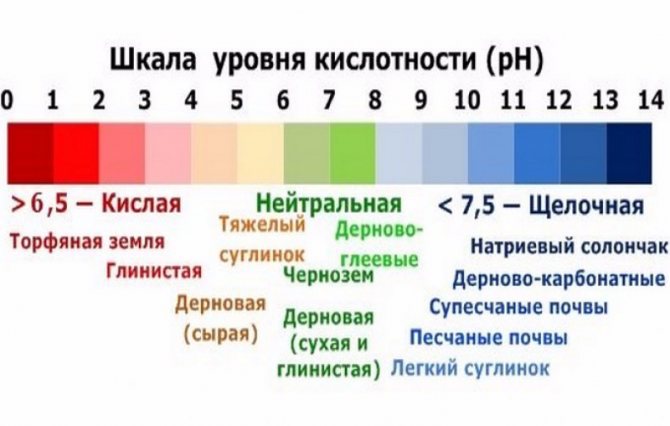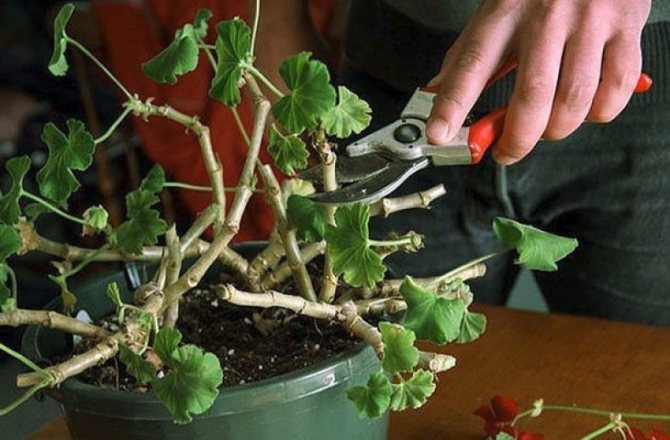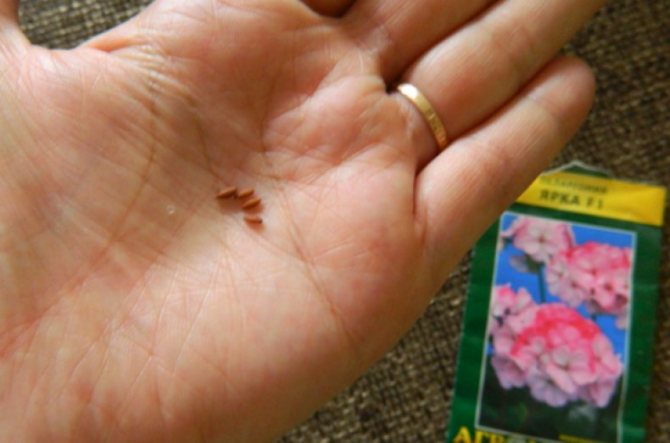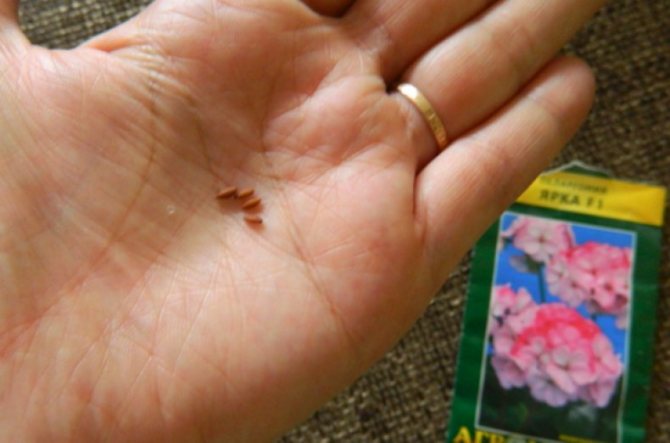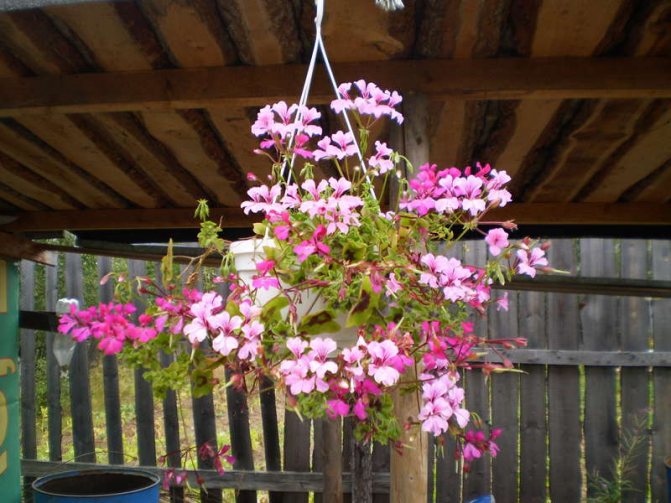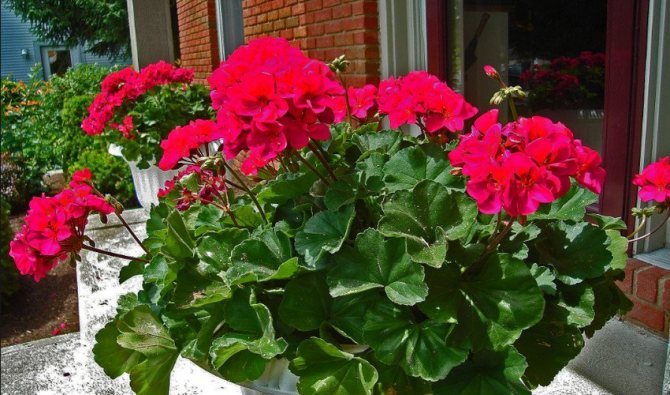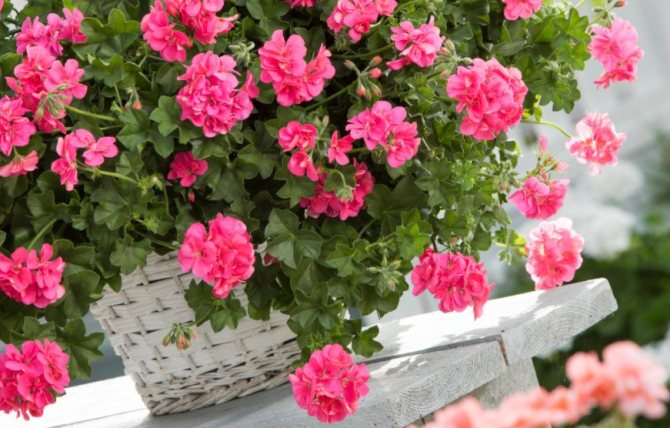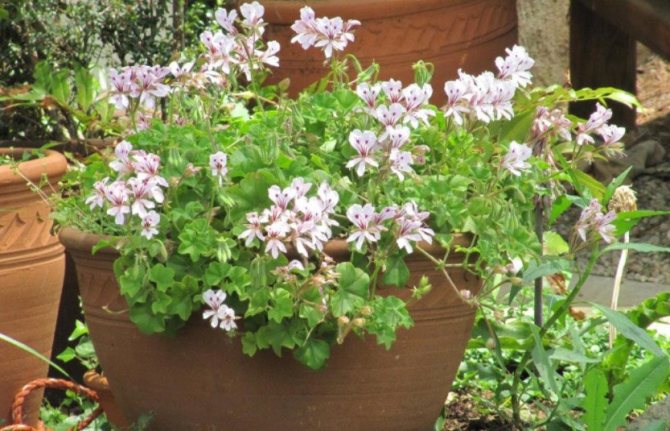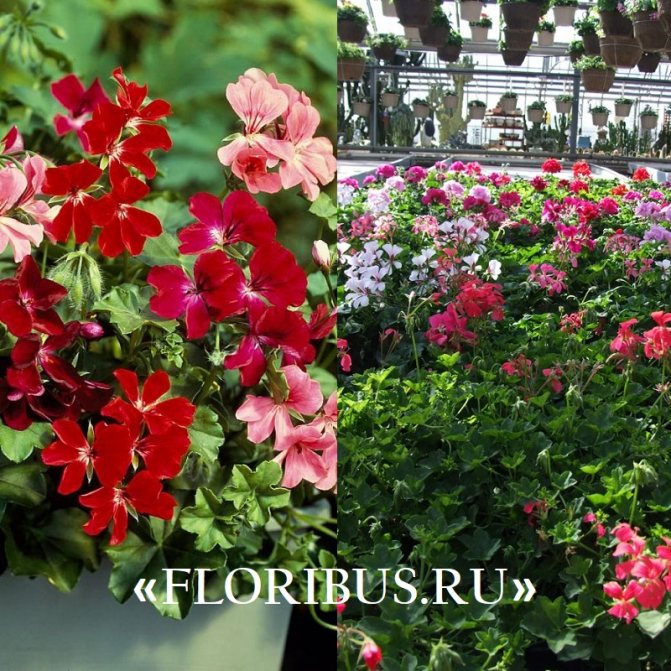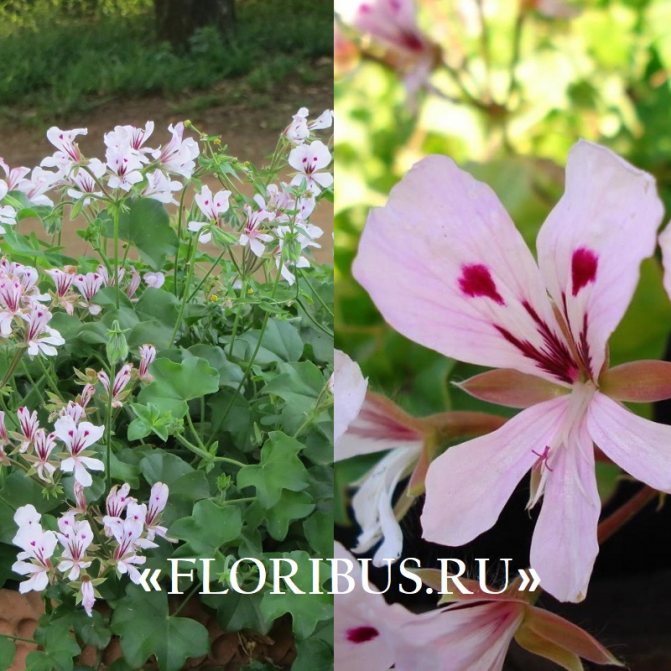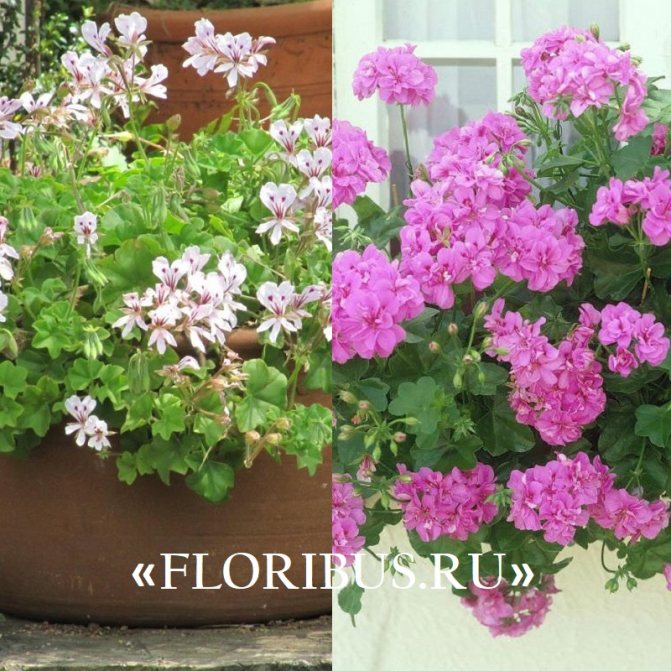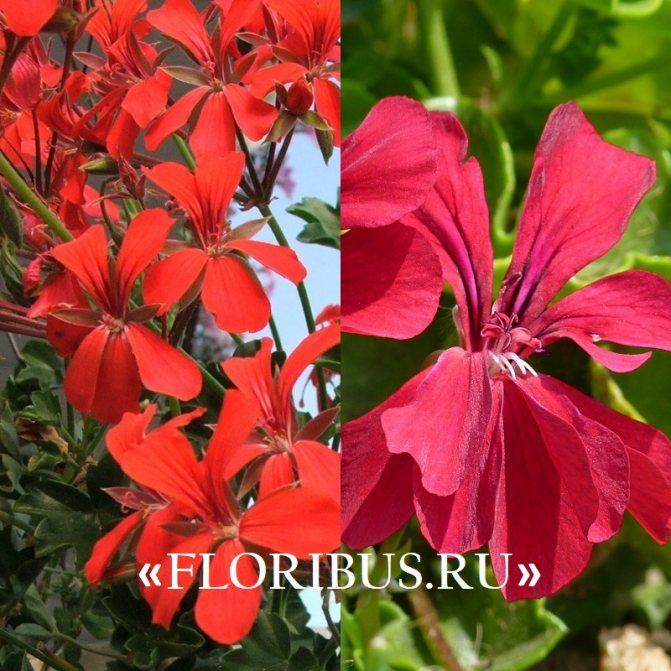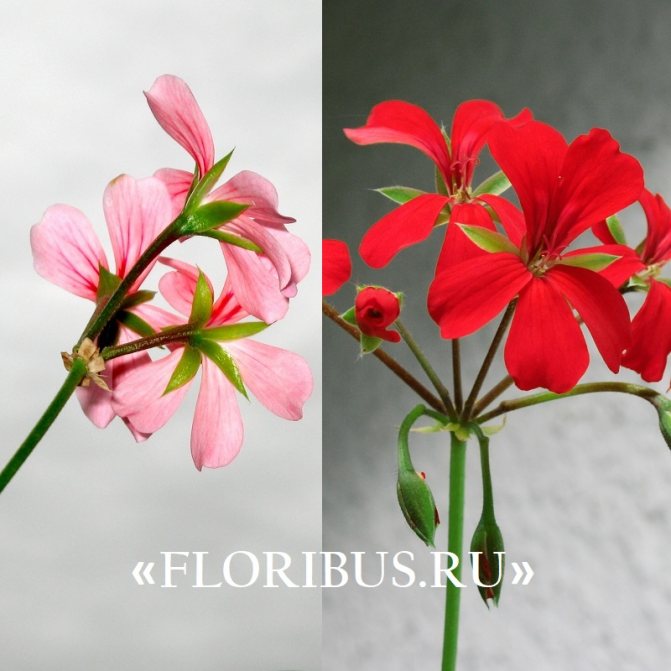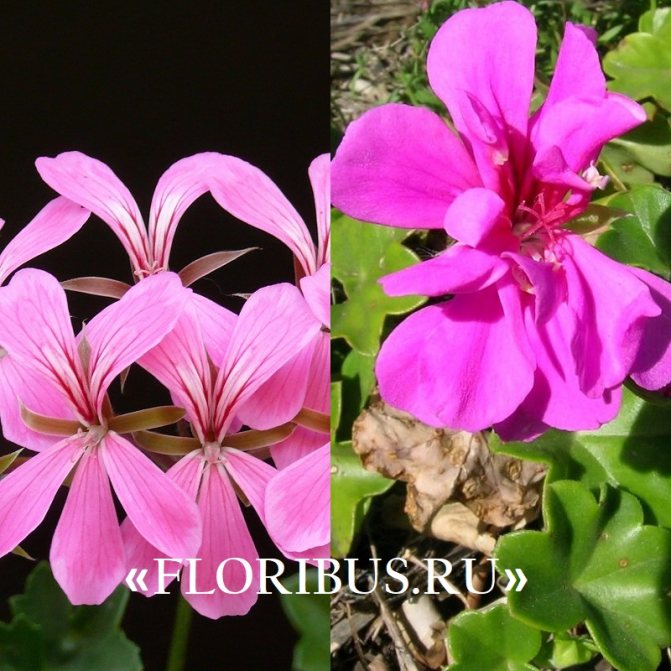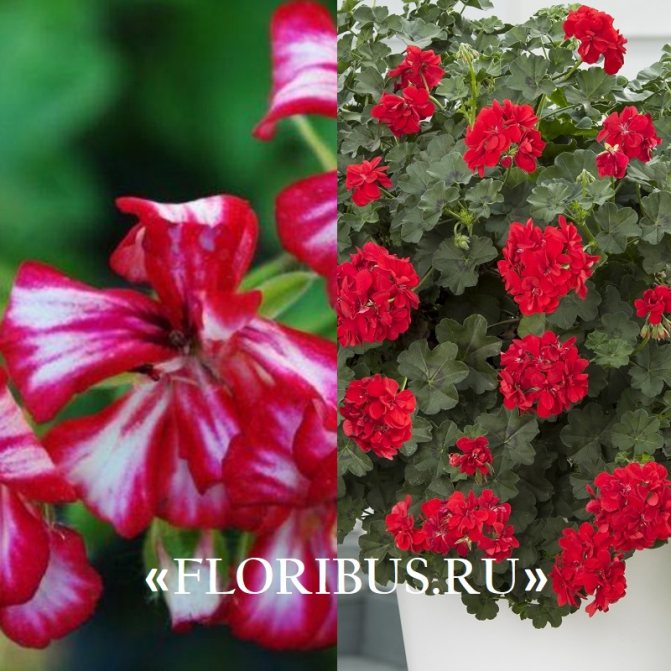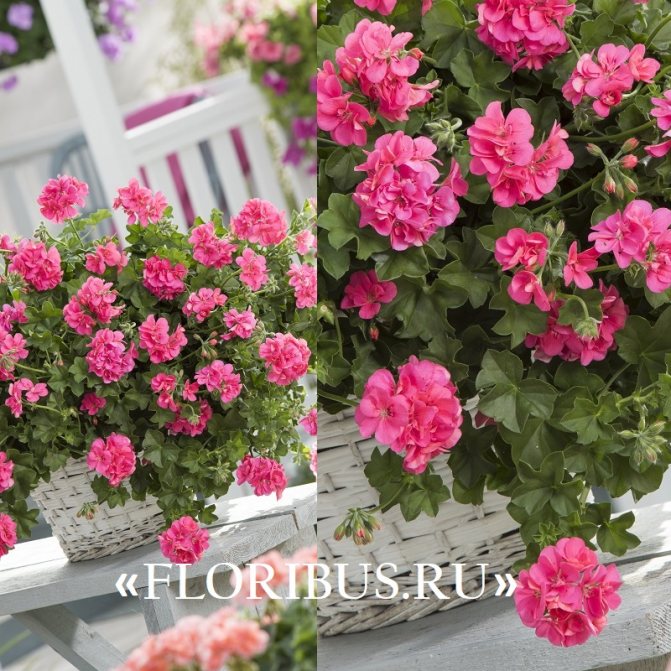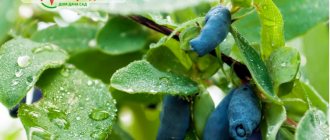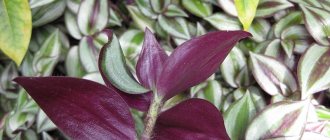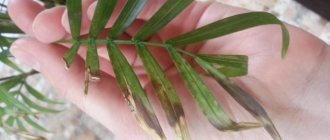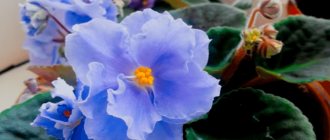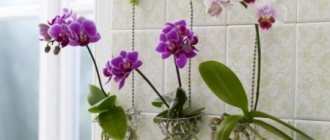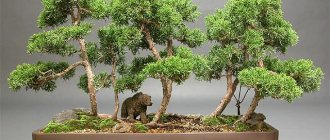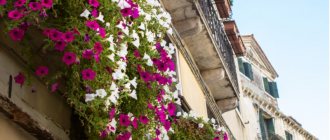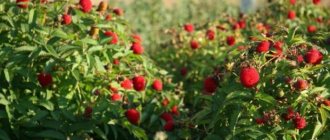Pelargonium ivy (otherwise thyroid geranium, lat.Pelargonium peltatum) is a popular plant among amateur flower growers. The plant looks great in a hanging basket and on a windowsill, it is used to decorate balconies and loggias. Used in decorating personal plots.
Pelargonium ivy is a herbaceous ampelous plant. The five-lobed, shiny leaves are like ivy. This is where the name comes from. The leaves are juicy and fleshy. Variegated forms adorn white with a cream shade or pinkish stripes along the edge of the leaf and along the veins.
Has strong creeping or creeping shoots. Varieties with a shoot length of up to one meter have been bred. Form a flowering carpet on flat ground. Shoots cling vertically and climb to the top. They go down from hanging baskets.
Umbrella flowers are similar to stars, 1.5 - 3 cm in diameter. Peduncles are short. The color of the flowers is different - white, pink, salmon, red, purple. Terry pelargoniums have flowers with different spots, with a border or striped.
Ivy geranium is a popular plant for landscaping and growing at home.
Pelargonium ivy is an unpretentious, abundantly and long-flowering plant. The decorative flower is planted in open ground, ideal for growing in hanging pots.
It is thermophilic, does not winter outdoors. Requires preparation for winter.
Breeding features
It is not difficult to propagate ivy geraniums at home. This can be done in two ways: by seeds and cuttings. The seed method is a difficult and painstaking way. Usually it is chosen by experienced florists. Seeds are planted from February to mid-April.
- The seeds are immersed in the soil to a depth of 1 cm.
- After that, the soil is well moistened, but not from a watering can, but from a spray bottle.
- Seedlings need to be provided with additional lighting and removed to a warm place.
- Next, you need to carefully monitor the temperature regime, it should keep in the range of 22-25 ° C.
- You can plant seedlings in permanent soil 3-4 weeks after sowing the seeds.
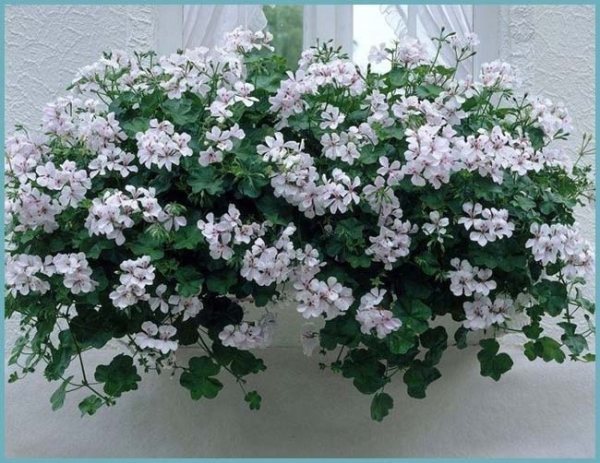
Geranium is simply propagated by cuttings
Reproduction by cuttings is much easier on one condition: there is where to get these cuttings. You need to do this in early March.
- Choose healthy and large cuttings, cut them off and let dry for 24 hours.
- Carefully process the sections with charcoal powder.
- Take the disinfected soil and plant the cuttings at a distance of 2 cm, compacting the soil well.
- After a month, the seedlings can be transplanted to permanent soil.
Common pests
Pests are a fairly common problem in cultivated pelargoniums. The provoking factors of their appearance are too high or low air humidity, excessive watering, proximity to infected plants. The main pests of ivy pelargonium and methods of controlling them are described in the table.
Table - Pests of ivy-leaved pelargonium
| Insect name | Characteristic signs | Ways to fight |
| Multi-claw mites | Brown scab on the underside of leaves | - Treatment with soapy water; - treatment with fungicides "Kemifos", "Antiklesh", "Jet" |
| Spider mites | - Leaves turn yellow; - the appearance of yellowish specks; - braiding with a thin cobweb | - Treatment of the affected areas with mineral oil; - spraying with "Akarin", "Vermitic" insecticides |
| Mushroom gnats (larvae) | Decay of the base of cuttings, seedlings | Young plants are prophylactically treated with preparations "Thunder-2", "Aktara", "Mukhoed" |
| Thrips | - The appearance of cork growths; - deformation of the growth point; - silvery bloom; - spots and holes on the petals | Repeated use of insecticides "Alatar", "Tsvetolux" |
| Aphid | - Sticky plaque; - twisting the tops of the shoots | - Washing with soapy water; - treatment with insecticides or infusion of tobacco dust |
| Caterpillars | - Bites on the leaves; - black feces of caterpillars | Insecticide treatment "Zolon", "Fitoverm" |
| Whitefly | - White butterflies; - pale yellow larvae; - yellowing of the leaves; - sticky discharge | - Using traps for adult insects; - use of insecticides "Aktara", "Inta-vir" |
Since it is rather difficult to care for ivy-leaved pelargonium, beginners are advised to start their flower cultivation experiments with more unpretentious, disease-resistant plants. Ivy-leaved pelargonium retains its decorative effect and blooms profusely only in favorable conditions.
Soil selection, complementary feeding and replanting
Geranium ivy ampelous is unpretentious to the soil. The only condition is its fertility.
Advice. Best of all, geranium takes root and grows in the soil of 5 components: peat, leaf, turf and humus soil, sand. All of these should be used in equal amounts.
This plant does not need a large and spacious pot. On the contrary, a small and even cramped pot or planter is the best place to grow geraniums. The optimal size is the roots are located 1-1.5 cm to the walls of the pot.
Geraniums are fed only in spring and summer. This is done every ten days using potash fertilizer. You don't need to do this in autumn and winter.
The ampel geranium must be transplanted, as it grows and the pots become too cramped for it, and the soil becomes depleted. This happens once every 2 years. The best time to transplant is spring. Even if the plant has not grown, you need to at least update the soil - add peat soil there.
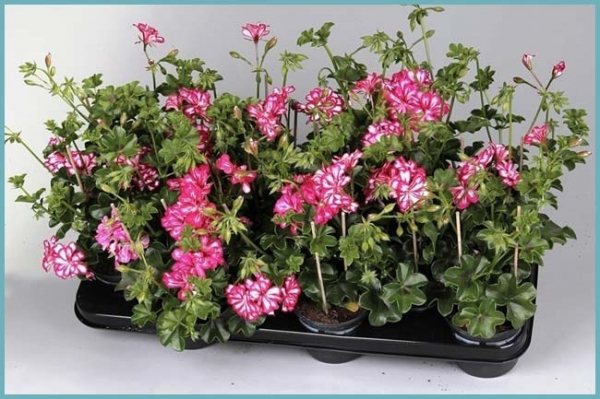

Young plants
Pruning
The formation of ivy pelargonium consists in timely pruning and pinching. This is a necessary measure to maintain the decorativeness of the ampelous culture and stimulate flowering. How to prune ivy pelargonium correctly?
The main pruning occurs in the fall. Shoots are cut off strongly - seven leaves are left. Root shoots are not touched, only axillary shoots are cut off. Dried and bare stems are also removed.
If during the wintering pelargonium managed to grow, it is cut again. Further, throughout the growing season, wilted inflorescences, dried leaves are cut, and the bushes are thinned.
Caring for Pelargonium ivy after flowering consists in removing wilted peduncles, pruning and preparing for a dormant period. Top dressing is minimized, watered less often, the flower begins to gradually accustom to low temperatures.
Rules for successful cultivation and care
Caring for geraniums, compared to other indoor plants, can be called simple. Good soil and a small pot are practically the keys to success. Nevertheless, for lush flowering, you need to follow a few more rules for caring for the plant.
This houseplant is very fond of light, which is not always enough in modern apartments. Since you cannot get direct sunlight in the house, it is best to put the ivy-leaved pelargonium pot on the windowsill on the south side.
In summer, geraniums should not be overheated, the optimum temperature is up to 25 ° C. In winter, the plant seems to go to rest, at this time the best temperature for it is 15 ° C. It must be kept away from heating appliances.
Drought is not terrible for a flower, but too humid air is harmful. You need to water the geranium from below and no more than 1 time in 2 weeks.
Attention! The African plant Pelargonium does not like moisture. Therefore, they do not need to be sprayed with a spray bottle. Otherwise, the leaves of the plant may start to rot. They will also develop various diseases.
The splendor and flowering of geraniums is provided by feeding with potassium. Nitrogen, on the other hand, harms the plant.
Description of the plant
An evergreen shrub geranium with long creeping shoots. It is actively grown in apartments as an ampelous crop, in the southern regions it is planted in open ground for vertical and horizontal gardening. Natural habitat of growth of ivy pelargonium - South Africa. The name is due to the uncharacteristic shape of the leaves for pelargonium - they resemble ivy foliage.
Shoots are very long, curly, flexible. The leaves are soft, with a smooth glossy surface. Ivy-leaved pelargonium has gained popularity among gardeners with its unusual leaf shape and long flowering. The plant is quite hardy - from April to October it can be kept on the balcony.
It blooms with simple or double flowers, collected in umbrella-shaped inflorescences. There are many hybrid varieties with a variety of colors. There are specimens with pink, purple, crimson, white, orange and multi-colored flowers. Flowering occurs in the spring and summer. Therefore, autumn needs special care for the flower.
Some growers form beautiful standard trees from ivy-shaped pelargonium. The formation process is long and difficult. Only one strongest shoot is left, the rest are cut off. The shoot is shortened, tied to a straight or winding support. Regular pruning and pinching achieve the formation of a lush crown.
Protection from pests and diseases
Indoor ivy ampelous geranium is susceptible to pests and diseases. Most often, these plants are adapted for themselves by caterpillars and slugs. They feed on pelargonium leaves. Getting rid of them is not easy. To do this, you need to use systemic insecticides.
Due to improper care and poor conditions, plants can be susceptible to rust, flower mold, blackleg and viruses. Geraniums are treated with special chemicals.
Ivy ampelous geranium is a very beautiful plant that, with proper care, will delight its owners with bright red flowers for many years. And if you open the directory of traditional medicine, you can find out about the manufacture of medicines from pelargonium.
Common diseases
Like most hybrids, Pelargonium ivy is susceptible to disease. The most common diseases, their symptoms and treatment are described in the table.
Table - Diseases of ivy pelargonium
| Name of the disease | Characteristic manifestations | Treatment methods |
| Flower mold | Mold on flowers | - Timely removal of wilted peduncles; - treatment with drugs "Fundazol" or "Fitosporin-M" |
| Swelling of leaves (edema) | - Deformation of leaves; - the formation of growths on the leaves | - Pruning deformed leaves; - reduction of watering |
| Leaf spot | - The appearance of spots; - growth inhibition | - Use of fungicides; - decrease in air humidity |
| Pelargonium rust | - Brownish-red spots; - leaf fall; - pelargonium does not bloom | - Removal of diseased leaves; - treatment with a systemic fungicide; - isolation from healthy plants |
| Curl virus | - Pale yellowish spots; - curly leaves | - Pruning of slightly affected plants, followed by treatment with a fungicide; - destruction of heavily affected plants |
| Blackleg | - Blackening of the root part of the stem; - weakening, death of the plant | Rooting healthy cuttings to replace a diseased flower |
| Gray rot | - Brown spots; - fluffy gray bloom; - leaf spot | Treatment by means of "Vitaros", "Fundazol" |
| Alternaria | - Brownish spots with a light middle; - fluffy bloom; - lack of flowering; - yellowing and drying of leaves | Spraying and watering with preparations "Ridomil Gold", "Skor" |
| Rhizoctonic rot | - Dark spots appear on the stems; - lack of flowering; - lethargy, yellowing of leaves | - Termination of watering; - spraying with solutions "Rovral", "Vitaros", "Fundazol" |
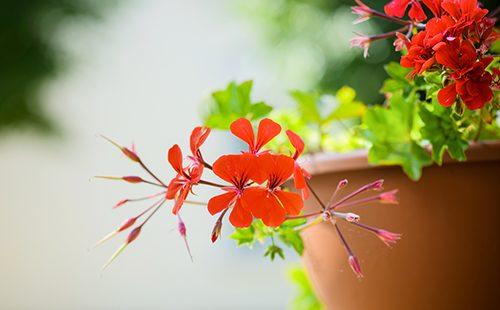

Ivy geranium: photo
Optimal conditions for ivy pelargonium
This beautiful ampelous plant is a close relative of geranium, but still differs from it:
- long hanging stems;
- the ability to curl or creep, reaching a length of 1 m;
- smooth, even and hard leaves. It is to the leaves that the flower culture owes its name: they are small, dark green and outwardly resemble ivy.
Ampel pelargonium needs personal conditions for development, sometimes different from those that are suitable for other varieties of geraniums.
Things to consider:
- The soil is nutritious, loose enough to retain moisture. At the same time, stagnant water is fraught with root rot. It is necessary to ensure that in the intervals between waterings the soil has time to dry out properly. To do this, there must be good drainage at the bottom of the pot. The optimal potting mix for a flower consists of garden soil, peat and sand, taken in equal parts.
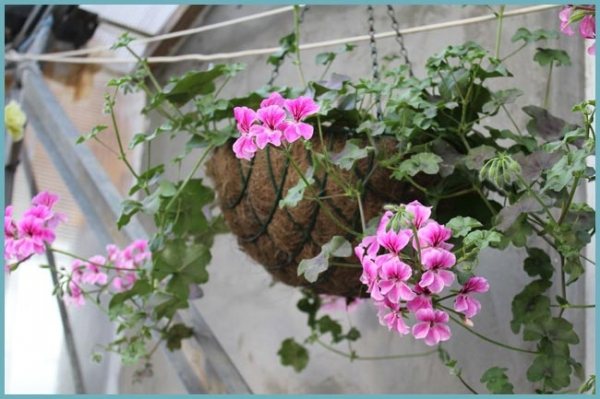

Pelargonium looks great in a planter
- Lighting. Like its related cultures, ivy-leaved pelargonium prefers bright sunshine. Lush greenery and abundant flowering are guaranteed only if the planter with the plant is located on the south side of the house. In the summer, pelargonium should be slightly shaded, and in the winter - placed where there is more natural light. Additional lighting can be arranged if necessary.
- Temperature. Although Pelargonium is ivy and is considered a "native" from Africa, she does not like the heat. In summertime, the optimum temperature for it is + 20 ... + 25 ° C, and in winter the mercury column should not exceed + 12 ... + 15 ° C. The admissible minimum in the cold season is + 8… + 10 ° C.
Advice. In a residential apartment, it can be problematic to create optimal temperature conditions for pelargonium when it comes to winter. Therefore, if the thermometer reads above +15 ° C, compensate for the lack of coolness with abundant lighting.
- The size of the flowerpot. It is necessary to choose a pot in which the distance from the roots of pelargonium to the walls of the container is about 1.5-2 cm.The approximate diameter of the flowerpot for one plant is 12-14 cm, for 3 or more plants - 22-25 cm. Too large capacity can cause pelargonium to stop blooming, but release greenery abundantly. Also remember that in a plastic pot the soil dries out worse and longer than in a clay pot.
What is the difference between an ivy plant and a regular one?
Ivy geranium is an evergreen plant of the Geranium family. It got its name from the shape of the leaves, which look like ivy leaves. If in the usual they are soft with a velvety surface, then in ivy they are hard and smooth to the touch. Their common characteristic is long branches that hang down. In ordinary geraniums, the stem is vertical and not long, and in ivy, flexible and curly. In this case, shoots can grow up to 1 meter.
Unlike other species, ivy geranium is unpretentious in care. and even a beginner can handle it. It blooms profusely and takes root quickly, both in water and in soil. Flowers come in various shapes and colors. But in comparison with ordinary geraniums, it does not tolerate winter well, does not like drafts and it definitely needs additional lighting with phytolamps. At the same time, it is prone to root rot.
How to care for pelargonium in winter
In the fall, pelargonium must be returned to a room that should not be too warm.The temperature of the content should be between 7 ° C and 15 ° C.
During this period, you need to reduce watering so that the roots do not die. The soil needs only to be slightly moistened without touching the leaves and stems. Geranium can hibernate on a cool windowsill inside the house, with the onset of warmth it can be planted in a summer cottage.
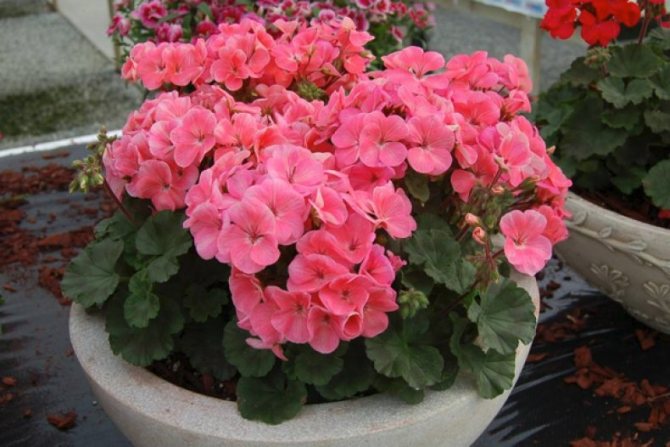

Care problems
Plant leaves can dry out due to lack of moisture in hot weather. You just need to moisten the earth, prevent the soil from drying out.
If the bush does not bloom, then this is due to a lack of nutrition, or it is planted too much in a spacious pot. In order for the plant to bloom, it is important to feed it on time and transplant it into a smaller container.
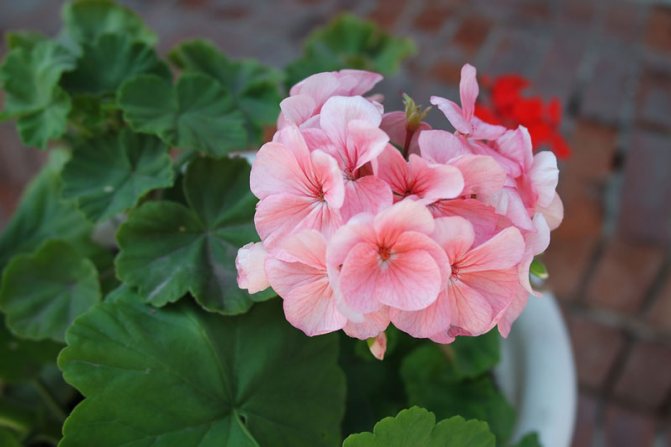

If you give the plant a little time and love, it will delight you with beautiful bright flowers.
Growing pelargonium: photo
Soil requirements
The ivy geranium, like all its other relatives, prefers neutral and alkaline soils. If the soil is too acidic, it is necessary to achieve a neutral reaction with the help of lime.
Even more harmful to the roots of ivy geraniums heavy, dense soil, contributing to the stagnation of water. In combination with the cold, waterlogging can cause root rot and kill the plant.
You can make the soil looser, lighter and more permeable by adding sand, peat and deciduous compost to the loamy soil.
How to choose a flower in a store and take care after purchase
Look for buds, not flowers in full bloom. Assess the condition of the plant. Spots on leaves and stems, lethargy, bare lower part of the shoots - all this indicates that the flower is sick or does not receive the necessary care. How to care for ampelous geraniums after purchase?
- Quarantine. For two weeks, geraniums are placed separately from the rest of the flowers. Initial signs of illness or pests in the store may go unnoticed. During this period, they will definitely prove themselves. Quarantine is necessary not only to facilitate adaptation, but also to protect other flowers from infection.
- Watering and feeding. At first, curly geraniums should receive a moderate amount of moisture. There is no need to feed. Fertilization facilitates adaptation, but leads to weakening of the plant later.
- Lighting. The purchased plant is placed in a well-lit place, but protected from direct sun. It is recommended to put it not on a windowsill, but on a bedside table or table next to the window. After a period of adaptation, they gradually become accustomed to brighter lighting.
- Transfer. If the condition of the soil is satisfactory, there is no need to rush with a transplant. Excessive stress will lead to a weakening of the plant, making it difficult for its adaptation. It is better to transplant in three weeks, when the flower takes root in a new place. If the geranium was purchased in the fall or winter, it is better to postpone the transplant until the spring.
Caring for ampelous geraniums after transplanting is gentle. The transplanted plant is kept in a warm place, shaded from the sun, watered regularly, but in moderation. The roots have not yet taken root - abundant watering will lead to their decay. Top dressing is stopped for two months - there are enough nutrients in fresh soil.
Beginners often make the mistake of washing the roots from the old substrate during transplanting. It is better not to do this - the roots are injured, the geranium is harder to take root in a new pot. The roots are washed only in special cases - if the plant is sick, the roots began to rot. They are pruned, rinsed in a fungicide solution, the plant is planted in a new sterile soil.
A bit of history, botanical characteristics
The ivy variety was introduced from Africa at the end of the 17th century.... It received its recognition due to its specific smell, curly shape and decorativeness. Cascading stems reaching 70-100 cm in length are a great decoration for vertical structures.
reference... During the flowering period, the bush is covered with umbrella constellations with a rather large top diameter.Each single umbrella has up to 50 flowers on long shoots.
The colors are striking in the variety of shades. Rigid foliage covers the vine with an emerald carpet.
Appearance and features of flowering
A feature of ampelous pelargonium is the falling shoots, the length of which can be from one to one and a half meters. Shoots are able to curl along the walls or hang effectively, so the plant is actively used for vertical gardening.
The color palette of inflorescences is diverse: ampelous pelargonium flowers can be white, purple, scarlet, red, pink. The tone can be heterogeneous: there are varieties in which flowers are speckled, striped, with a border and spots. Flowers can be simple or double.
The duration of each flowering is 5 - 6 days. Flowering time is from mid-spring to mid-summer. The glossy leaves of the plant are five-lobed, their width is 3 - 6 cm. Their color is interesting: depending on the variety, it can be saturated green or white - variegated.
In the 18th century, flower growers and breeders in England and the Netherlands bred a species of plant that was very similar to African pelargonium. They called it geranium. Karl Linnaeus in his treatise "The System of Nature" united them into one genus. But African and European plants have a different flower structure and other differences, therefore, in the modern classification, pelargonium and geranium are representatives of different genera. Hence the confusion in many information sources, mistakenly substituting one name for another.
Geranium and Pelargonium are two different plants!
Interesting Facts
Studying the history of ampelous geranium, the following interesting facts are highlighted:
- George Tradescan, an English breeder, warmly called each of his new offspring a butterfly (remember the Tornado variety). The pinnacle of skill was the royal geranium, which cured the king of insomnia.
- The legend of the dead crane is touching. A blanket of snow enveloped the lifeless, frozen body. From a teardrop that has rolled out in the spring, amazing flowers have grown, reflecting the heavenly blue. The crane missed him so much. This flower was named - ampelous geranium.
- Eastern history tells of an incident that happened to the prophet Muhammad. As a weed, the bush of the field geranium with its branches helped dry the clothes of the seer, who, in gratitude, showered him with magnificent flowers.
The favorite of the people is a home healer and protector from quarrels, resentments and strife. An example is the legend of a German shoemaker who, instead of catching up with his wife, acquired peace in the family after he gave her this wonderful flower.
If you find an error, please select a piece of text and press Ctrl + Enter.
The choice of planting material
Modern flower shops offer for sale various varieties of terry pelargoniums, plants with simple inflorescences, among which it is worth choosing the most suitable planting material. In order not to be mistaken, it is advisable to study the information about the species of interest in advance. Below are descriptions of several varieties, crop hybrids, consistently receiving approving reviews from flower growers.
Pelargonium Crystal Queen f1
Wonderful Pelargonium Crystal Queen f1 is a powerful plant that can easily be grown from seeds. The bushes of this hybrid in the amount of 1 - 2 pieces are allowed to be planted in a large hanging basket.
Unpretentious pelargonium ampelous Crystal Queen f1 red is characterized by the presence of hard leaves, strong, shoots up to 30 cm long. It endures rainfall and wind. On one plant, about a hundred beautiful flowers can bloom at the same time. The culture is recommended for growing in hanging pots, balcony boxes, mixed containers.
Pelargonium Tornado f1
The magnificent Tornado f1 pelargonium is bred by Dutch breeders.European gardeners speak of the plant extremely positively. This red pelargonium with shoots of 30 cm or more looks great in hanging baskets and is often used for landscaping. The flowering of a crop that does not need the use of growth stimulants is likely to be long and abundant.
Pelargonium Tuscany
The popular Pelargonium Tuscany has many varietal forms. They all look extremely attractive. The ampelous pelargonium Toscana Eva is in particular demand, which delights florists with large white flowers blooming on hanging shoots about 50 cm long. The flowering of the culture starts in May and continues until frost.
How and when to trim
Pruning ampelous geranium stimulates the growth of lateral shoots, maintains the neat shape of the bush, rejuvenates the plant, and promotes abundant flowering. Without pruning, the decorativeness of geraniums quickly decreases, the bush looks disheveled, blooms worse.
Pruning is carried out at the beginning of the dormant period - in the fall. Very lush plants require more strength to recover - weak inflorescences may form in the next flowering. When pruning in autumn, the main shoots are shortened to seven leaves, the lateral ones are cut off. Young lashes coming from the root do not touch.
If geranium has grown over the winter, pruning is repeated in the spring. Extra, weak stems are removed. Throughout the spring, they continue to pinch the ampelous geranium, removing the tops of new shoots after the fifth leaf. Regular pinching forms a lush, neat crown.
For trimming, only sharp sterile tools are used - blades, well-sharpened scissors or a clerical knife. The blade of the tool is preliminarily wiped with alcohol and scalded with boiling water. Pinch the shoots with clean hands.
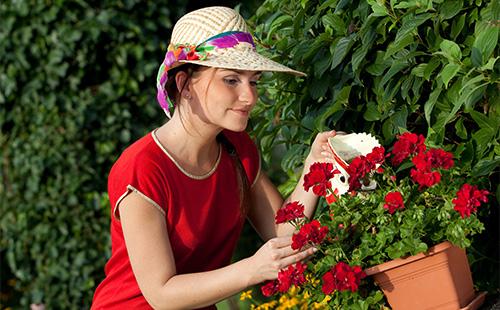

Planting instructions
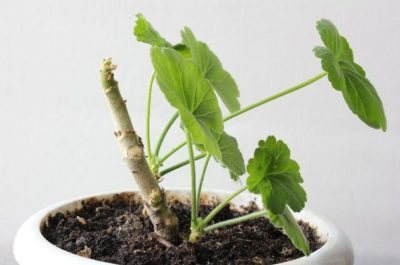

Prepare everything you need: a container, a seedling (preferably a few for a beautiful bush shape) ampelous pelargonium, drainage, soil, watering can, spatula.- The pot is covered with a drainage layer (approximately 1/4 of the total volume) and soil.
- In the container, with a spatula, depressions are made alternately into which pelargonium seedlings are immersed at the same distance from each other.
- Each seedling is covered with earth, which should be pressed firmly at the base of the shoot for better fixation.
- The plant needs to be watered.
Ampel Pelargonium does not tolerate stagnation of moisture in a pot, which can provoke rotting of its roots. Therefore, you should not forget about the drainage in the pot (expanded clay, chipped brick, broken foam, etc.), as well as the drainage holes in the bottom of the container, designed to drain excess liquid.
Lighting and location
Ampelous pelargonium loves the bright sun, requires a sufficiently long daylight hours for full development (about 16 hours). The flower tolerates dry periods relatively easily, and feels great outdoors. The best place to stay for pelargonium in the warm season will be balconies, windows, gazebos, terraces or flowerpots displayed on the backyard. Desirable direction - south, southeast, southwest.
Soil requirements
The soil, which is optimally suitable for planting ampelous pelargonium, should have such characteristics as looseness, lightness, air and moisture permeability. An indispensable element of the substrate that meets all these requirements is peat and coarse sand. Ready-made soil can be bought in a store or prepared with your own hands: in a ratio of 1: 1: 1: 1, mix peat, sand, turf, leafy soil.
Diseases of ampelous pelargonium
Since the plant spends a lot of time on the balcony or in the garden, it is exposed to negative environmental influences. High humidity, temperature changes, mistakes in care often provoke pelargonium diseases, signals of which are the appearance of rusty, dry spots, light areas, and a yellow mosaic pattern on the leaves.
The greatest harm to the culture is caused by fungal infections, chlorosis, viral mosaic. To cope with ailments will help the treatment of bushes with the help of special means, adjusting the schedules of watering, dressing. Effective preventive measures are: disinfecting the soil, loosening the soil, removing yellowed, fallen leaves, cutting off wilted inflorescences.
Thinning pruning of ivy pelargonium is necessary, which makes it possible to avoid excessive density of bushes, ensuring their ventilation.
Description and photos of popular varieties
This plant has many varieties, the most common of which are:
- Amethyst - flowers are large, have amethyst-purple color, turning into crimson. The leaves are green, shiny.
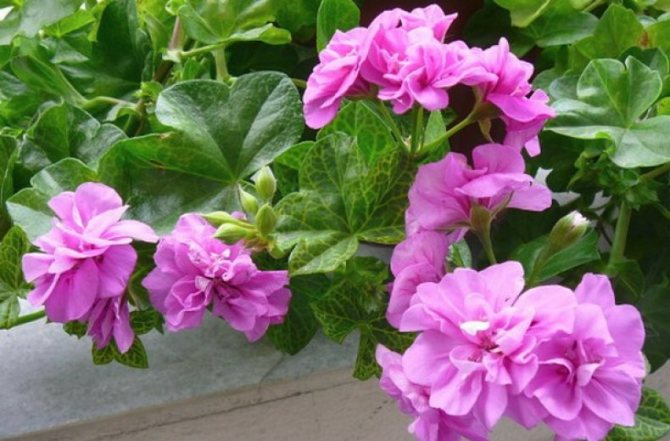

- Crocodile - the leaves have an original color, bright yellow veins are clearly visible on them. The flowers are pink-coral.
